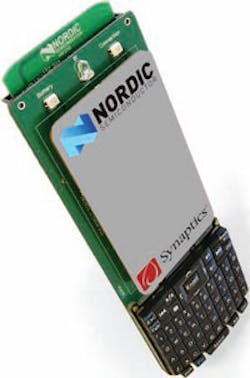Reference Design Helps Remote Controls Do Justice To TV GUIs
According to DisplaySearch, the market for Internet-enabled television sets (not including devices like set-top boxes and media players) is forecasted to reach 123 million shipments by 2014. This estimate represents a sustained 30% compound annual growth rate (CAGR). Because TVs and set-top boxes are increasingly becoming Internet-enabled, advanced navigation and browsing control is required to maintain a rich and engaging user experience. As a result, infrared (IR) "one-button one-function" remote controls are more often proving inadequate.
RF technology is emerging as a suitable alternative, as it can provide sufficient bandwidth for advanced functionality like navigation interfaces. Examples include scroll wheels, touchscreens, and track balls. It also provides the bi-directional communications that is required when negotiating the complex user interfaces and menus that are typical of modern media devices. The problem with using RF technology is that remote controls have very limited battery power. RF devices, of course, consume much more power than traditional IR solutions.
"You shouldn't have to dock your remote control every day ," says Thomas Embla Bonnerud, Product Manager at Nordic Semiconductor. "That's where ultra-low-power wireless comes in. IR and buttons are not the solution." Nordic Semiconductor just announced a new remote-control reference design. Using 2.4-GHz RF, it enables the use of advanced human-machine interfaces, such as touchpads, by consuming very little power. The nRFready 2.4-GHz Smart Remote reference design features a multi-touch touchpad, six-axis motion sensing, and a full QWERTY keyboard (on the back of the remote; Fig. 1). The reference design uses Nordic's nRF24L series of systems-on-a-chip combined with its Gazell 2.4-GHz RF protocol stack.
With the Synaptics multi-touch touchpad, the reference design supports pointing, scrolling, and tapping gestures as well as a range of more sophisticated gestures like zoom, flick, and rotate. Custom gestures also are a possibility. In addition, the design uses an ultra-low-power accelerometer from STMicroelectronics to enable intelligent power management. This accelerometer can be used for orientation detection if required. The six-axis motion-sensor solution is based on InvenSense's MPU-6050, which is an integrated three-axis-gyroscope plus three-axis-accelerometer combination.
Tom Dubil, Commercial Manager for the Americas at Philips Communication and Control, showed off one of Philips' latest TV remotes at a recent Nordic Semiconductor event. The Dual IR/RF remote handset uses a Nordic nRF24LE1 ultra-low-power, 2.4-GHz transceiver (Fig. 2). That transceiver runs a modified version of Nordic's Gazell RF protocol. Dubil said that the unit could last two to three months powered by a coin cell or as long as a year on AAA batteries. Replacing the touchpad with buttons extended the life of a coin-cell battery to five years.
The Dual remote features a touchpad for advanced gestures, such as swiping. "When you're doing this kind of swiping, IR has its limitations," Dubil explains. "RF is fast and responsive and lower power, so we can make better form factors that are more ergonomic and have fewer buttons."
Another big challenge for remote controls is that they have to work in an environment that is becoming increasingly noisy due to the presence of other WiFi and Bluetooth devices. According to Nordic, the combination of its hardware and the Gazell 2.4-GHz protocol in the Smart Remote reference design delivers the bandwidth, latency, and co-existence performance to support all of its advanced features in this environment. The nRFready RF Smart Remote reference design kit includes the Nordic Smart Remote baseboard, Smart Remote 2.4-GHz radio module, 2.4-GHz RF dongle, and programming adapter.
About the Author
Sally Ward-Foxton
Associate Editor
Sally Ward-Foxton is Associate Editor of Electronic Design Europe. Her beat covers all areas of the European Electronics industry, but she has a particular interest in wireless communications and display technology. Based in London, Sally holds a Masters Degree in Electrical and Electronic Engineering from the University of Cambridge, UK.
